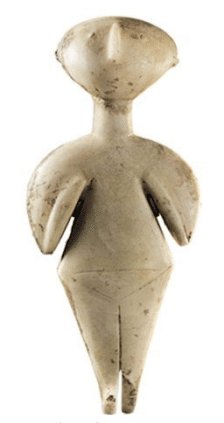Who Owns the Stargazer?
March 29, 2023

The Stargazer
(image from Second Circuit opinion)
Claims relating to the ownership of movable property generate an impressive amount of transnational litigation. In April 2022, the U.S. Supreme Court decided a long-running case about the ownership of a painting that had been expropriated by the Nazis in 1939. In July 2022, the U.S. District Court for the Northern District of New York heard a case relating to a Ferrari that was reported stolen in Italy in 2003. And earlier this month, the U.S. Court of Appeals for the Second Circuit was called upon to determine the owner of an ancient statuette known as the Stargazer.
The Stargazer
The Stargazer was crafted between 500 B.C.E. and 400 B.C.E. Although it was originally made in Anatolia, within the borders of modern-day Turkey, it was removed from that area at some unknown time in the past. There is no evidence of its findspot, find date, or excavator.
The Stargazer first appears in the historical record in 1961, when an art dealer in New York sold it to Alastair and Edith Martin. The Martins loaned the idol to the Metropolitan Museum of Art (“Met”) from 1968 through 1993. During this time, the Stargazer was displayed publicly in the Met’s permanent galleries, with its origin listed as Anatolian. The Martins sold the Stargazer to the Merrin Gallery in 1993, and the Gallery resold it to Michael and Judy Steinhardt that same year. The Steinhardts likewise loaned the Stargazer to the Met, where it was exhibited from 1999 to 2007. Its origins were again listed as Anatolian.
Between 1964 and 2014, the Stargazer was also referenced in several publications. In 1989, a well-known Turkish newspaper mentioned that the idol was a part of a private art collection in New York. In 1997, the Turkish Ministry of Culture published an essay on its website that specifically referenced the Stargazer. And in 2014, an archaeology professor at Istanbul University referenced the idol in a book on Anatolian art.
The Suit
In 2017, the Steinhardts consigned the Stargazer to Christie’s Inc. (“Christie’s”) to be sold at auction. Although the statuette received a bid of $12.7 million, the sale was never consummated. Shortly after the Stargazer was listed for sale, Turkey brought claims for replevin and conversion against the Steinhardts in federal district court as a matter of New York state law on the basis of diversity jurisdiction. Turkey requested a declaratory judgment that all rights, title, and interest in the Stargazer belonged to Turkey. The Steinhardts counterclaimed against Turkey, requesting a declaratory judgment that all rights, title, and interest to the Stargazer belonged to them.
In 2021, the U.S. District Court for the Southern District of New York (Judge Alison J. Nathan) ruled in favor of the Steinhardts. It concluded that Turkey had failed to establish an ownership interest under Turkish law because it had not carried its burden of proving by a “preponderance of the evidence” that the idol was found within and exported from the boundaries of modern-day Turkey after 1906. The district court also concluded that Turkey’s claim was barred by the doctrine of laches because Turkey knew or should have known about the idol’s existence well before 2017 and its delay in bringing suit was inexcusable.
The Appeal
Although the Second Circuit (Judge Rosemary Pooler) held that the district court had erred in holding Turkey to a “preponderance of the evidence” standard rather than a “threshold showing” standard as to whether the Stargazer was found in Turkey after 1906, it affirmed the decision of the district court on the issue of laches.
The court explained that laches is “an equitable defense, precluding the claims of a plaintiff who is guilty of unreasonable and inexcusable delay that has resulted in prejudice to the defendant.” The Second Circuit held that Turkey should have known about the statuette well before 2017 because the Stargazer was listed as Anatolian in public displays for decades and because its Anatolian origins were discussed in several different publications. The court observed that “Turkey sat on its hands despite signals from its own Ministry of Culture that the Stargazer was in New York City.” The court further held that Turkey inexcusably delayed in taking action to assert rights to the Stargazer. Finally, it held that the Steinhardts were prejudiced by this delay because several key witnesses who may have been able to shed light on the statuette’s origins had passed away in the meantime.
Conclusion
New York law generally offers robust protections to persons seeking to reclaim stolen art and artifacts. Those seeking to recover these objects must, however, assert their rights in a timely fashion or risk losing them altogether.